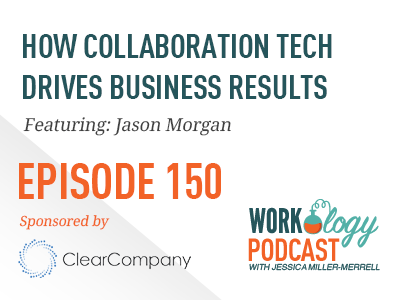Work collaboration tools can be fantastic for getting things done and driving results within teams. They also can offer more than just efficiency – with today’s technology you can gain insights, data, and information that HR and business leaders often only dream of. This can happen with a variety of technology including artificial intelligence and machine learning to better understand how your employees get their best work done and really feel about working for your company.
Episode 150: How Collaboration Technology Drives Business Results with Jason Morgan (@jason_w_morgan)
As workplace technology grows in adoption, so does the way in which we leverage the data and information available as a result of that technology including collaboration technology like Slack, Facebook at Work, Yammer, and other internal communication tools. This week’s podcast guest, Jason Morgan shares insights from a recent report published by his team at Wiretap on Human Risk Behavior Analysis and Research. Jason is the Vice President of Behavioral Intelligence at Wiretap. Jason holds his PhD in Political Methodology from The Ohio State University, where he retains a Visiting Scholar position.
Jason says that these workplace collaboration technologies are used to break down silos within an organization allowing people to communicate in real time with the goal of increasing productivity and allowing a free flow of information in threaded conversations, free-flowing chats and messaging and organizational level announcements.
Jason and his team’s research found that private messages between coworkers and colleagues were more casual and more candid than public messages and threads. He says employees are privately sharing their opinions on projects and people via these private message chats instead of speaking up in in-person meetings, conference calls and via public internal messaging. Wiretap’s research found that those private messages were likely to have more negative sentiment than the public messages.
The Power of Real-Time Workplace Data Analysis
These research findings support what I have found in my own experience working in HR. Employees are more likely to share their true feelings in private meetings or employee surveys versus large and public groups. In my mind, this makes the internal messaging research and reporting that Wiretap offers more valuable as it provides business leaders real-time insights into the opinions, feelings, and sentiment of their employees.
Jason says he team provides data and analysis things like sentiment and toxicity for companies. Sentiment is a measurement of the mood or the feeling of employees toward the company towards the company culture or towards leadership. Toxicity, on the other hand, is a measurement of distracting I guess behaviors that have the potential to make people at work unsafe, isolated, or harassed. This can include things like unprofessional behavior like swearing general harassment or even discriminatory types of communication. The goal with this analysis and data Jason says is incredibly important because if a company and a leader can drill down into specific business units or work groups they can identify potential problems in terms of culture, engagement or collaboration.
[bctt tweet=”If we can associate different forms of communication with high performing groups versus low performing groups we can identify situations in a company where is potential to model behaviors & improve. – @jason_w_morgan #hr #shrm ” via=”no”]
The research and work that Jason and his team at Wiretap are do is truly amazing. Data is such an important part of where modern HR is moving towards. Analytics and information obtained through technology that incorporates machine learning and artificial intelligence help elevate our efforts in how we engage, train, retain, and work with our employees. Jason says he hopes that their findings and that modeling of social network interactions can help inform organizational structural or
are changes in structure and policies that could help improve productivity and really workplace culture in their customer’s networks.
Connect with Jason Morgan.
RECOMMENDED RESOURCES
What a Toxic Employee Can Cost Your Company
Why Collaboration Tools Boost Employee Engagement
The Challenge of Annual Employee Surveys
Human Behavior Analysis Research Trends & Benchmarks ~ Wiretap’s Research
How AI is Protecting Company Culture on Collaboration Platforms
4 Tips for Implementing Enterprise Collaboration Networks
Should Collaboration in the Workplace Be Required?
How to Subscribe to the Workology Podcast
You can also click here to find out how to be a guest on the Workology Podcast.
*A special thank you to my production team at Total Picture Radio.









